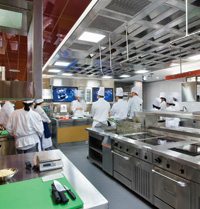When it comes to sourcing equipment, restaurateurs have their work cut out for them. Tight margins and increased competition often mean they have to get creative with their choices, from the kitchen to the tabletop. Whether choosing ultra high-tech, multi-function equipment to save energy and reduce labour costs, back-to-basics low-tech cookware, or innovative table settings for added pizzazz, there are plenty of options to suit any operation or budget.
Equipage
David Zabrowski, director of Engineering for the San Ramon, Calif.-based Food Service Technology Center, says there’s a lot of buzz around a few select equipment categories. “One of the biggest things is that induction is coming on strong. It’s not new, but with more reliable, robust and cheaper products from a bigger number of players, more and more companies are adopting it.” It’s not just cooktops anymore, he adds. “We’re seeing induction warmers, braising pans and griddles being offered by CookTek, Dipo and Electrolux. Garland is really stepping back up and making a serious commitment.” Interest in induction is most notable at the chain restaurant level. “Induction adds flexibility and the potential to operate without a hood. And, the low heat is a big deal when it comes to energy use and staff comfort,” says Zabrowski.
So, it makes sense that heat-recovery systems are being integrated into warewashing equipment. “This was pioneered in Europe, but it was slow to come here because of the added cost and complexity [associated with ventilation requirements],” Zabrowski explains.
Conversely, there’s a trend toward control systems on ice machines and walk-in refrigeration systems, he adds. The sophisticated units optimize cycles and save energy by directing the production of ice and by defrosting when needed.
Speed cooking is also being reinvented as incumbents such as Turbochef (with its G5 multi-level unit), and newcomers such as Dallas-based Ovention (with its conveyor product), offer innovative products with multi-functionality. “Speed ovens aren’t just for sandwiches and pizzas anymore,” Zabrowski says.
But it’s not just about speed. Combined functionality is critical at limited-service hotel and foodservice operations where it can be a challenge to find employees that possess refined culinary skills. “We’re seeing a lot of developments in terms of control, accuracy and functionality,” says Patrick Watt, principal with A Day in Life Foodservice Development, a Saint John, N.B.-based consultancy. “Accelerated cooking systems are really [catching] on now in limited-service environments, because they don’t need ventilation to operate.” For example, Rational is introducing ventless hood features that save mechanical costs and make it easy to move equipment. “Ventless hoods mean you can take that combitherm oven anywhere. It may cost $3,000 to $5,000, but you could easily spend more than that on a hood,” Watt says.
And, as consumers look to healthier, flavourful menu options, many chefs are opting for solid fuel cooking such as barbecuing, grilling and smoking. “Mobile barbecue systems are a trend that’s growing,” Watt says. “Southern Pride has got barbecues that are basically trailers.”
Even small grills have their place. Chef Jonathan Chovancek, co-owner of the Vancouver-based Bittered Sling event catering company, enjoys grilling, because he can create quality meals for catered events. “What I love about it is there’s a direct focus on heat
energy and flavour.” Depending on the size
of the event, one of his favourite tools is an inexpensive Bodum charcoal-only grill. “It’s exactly like a Weber but only has a two-and-a-half foot grilling service. It’s usually all I need.”
Stirring the pots
When sourcing pots and pans, a common-sense approach is best, advises John Higgins, director and corporate chef, Centre for Hospitality & Culinary Arts at George Brown College in Toronto. “You want good conductors of heat that come from a reputable manufacturer and will last years. I’ve got some phenomenal pans from WMF in Germany that are 20 years old.”
Tried-and-true products continue to be favoured in today’s kitchens. “I love cast iron,” Higgins says. “It’s solid and a great conductor of heat. Le Creuset pans, for example, are especially good for braising in the oven.”
Faizal Hassam, executive chef of Cibo Trattoria and Uva Wine Bar in Vancouver, admits he’s old school when it comes to pots and pans. “Our menu is rustic Italian, so we like to slow cook the food in the traditional way.” So, the chef looks for heavy, flat bottoms, since they hold the heat better, reduce the risk of burning and withstand a lot of wear and tear. “My favourite cast-iron skillet is a Le Creuset one. It cooks beautifully, is easy to clean, and it can [be transferred] from stove to oven without worry about toxic fumes,” says Hassam.
Another essential for Hassam is a large rondeau, a wide heavy-bottomed pot with straight sides. “It’s great for braising or even cooking risottos, because you have a wide canvas of heat to work with,” he says. But, when it comes to sauces, the chef prefers copper pots because of their heat-conducting properties.
Meanwhile, Rudi Fischbacher, professor and coordinator of Culinary Programs, for Humber College’s School of Hospitality, Recreation and Tourism in Toronto, recently switched to heavy-duty stainless-steel pots and pans from Browne.“The ergonomically shaped handle doesn’t get hot, so it’s great for preventing burns. It also uses uni-metal so the bottom is not added on after the fact, and there’s no chance of it cracking and splitting,” says Fischbacher. “They’re almost indestructible.” Whatever the brand, the key consideration should be the weight and thickness of the steel, Fischbacher says. He recommends 3/8 to 1/2 inch as a minimum base thickness.
Tableaux vivants
In the front-of-house, restaurateurs are differentiating themselves while reducing overhead costs. For example, linen is losing favour, due to the cost and labour involved in its upkeep, explains chef Michael Bonacini, partner, Oliver & Bonacini Restaurants in Toronto. Instead, the culinary boss of restaurants such as Luma, Bannock and Canoe, prefers dishwasher-safe eye-catching coverings, such as custom-cut and -coloured vinyl placemats to top bare tables.
And, wood, laminate and natural and man-made stones are among the popular backdrops for table settings. “There’s also faux finishes — ivory, leather, even metal mesh set in resin,” Bonacini explains. Rounding out the table’s finish are hardwood edges on laminate or metal banding (cold rolled steel, bronze or brass) that increase a table’s longevity, he adds. There’s also a revival of irregular edges.
Atop the table, cutlery remains simple and contemporary while white continues to be the go-to choice for dishware. That said, there is a trend toward dishes that make portions look larger, says Joel Sisson, president and founder of Crush Strategy, a Mississauga, Ont.-based foodservice consultancy. “We’re seeing plate surfaces shrink by one or two inches, because oversized plates are too hard to fill.” Adding height to the plate also helps, he adds. “Galvanized buckets for fries, for example, make it look like diners are getting better value.”
Restaurateurs are also getting creative with side plates, salt-and-pepper shakers and condiment caddies. “Individual salt-and-pepper shakers are great for sprucing up plates, and they’re not that expensive,” Sisson says.
In terms of glassware, vintage designs are making a return to cocktail circles. “What was dorky 10 years ago is in today, like gold-leaf-plated glassware from the Montreal Olympics. Vintage coupes [saucer-shaped glasses] are cropping up everywhere,” notes Lauren Mote, co-owner of Bittered Sling. As far as mainstream cocktail glasses are concerned, the mixologist and sommelier chooses classic styles with heavy bottoms that are wide enough to handle a two-inch-square ice cube. She adds: “The biggest bang for the buck [for wine glasses] is probably Spiegelau, while Riedel is great for specialized needs.”
Whatever the choices, durability is essential. “Opening inventory can cost $30,000 to $50,000, so choose your items well; stick to a brand, and don’t pick things that go out of fashion. It’s all about increasing longevity without compromising style,” advises Bonacini.





















